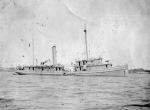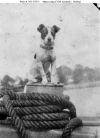NavSource Online:
Section Patrol Craft Photo Archive
Kenneth L. McNeal (SP 333)
George - Sail - Quack - Pup | Nan - Cast - Pup |
Trawler/Minesweeper:
Specifications:
| Commanding Officers | ||
| 01 | LTJG Carroll Beaver Byrne, USN - USNA Class of 1912 | 10 August 1917 - 1918 |
| 02 | ENS James B. Dryden, USNRF | 1918 - 1919 |
| 03 | LCDR Clarence Nelson Hinkamp, USN - USNA Class of 1907 Awarded the Navy Cross (1919) - Retired as Captain | 1919 |
|
|
View the McNeal (SP 333)
DANFS history entry located on the Naval History and Heritage Command website
| Back to the Main Photo Index | Back to the Patrol Craft/Gunboat/Submarine Chaser Ship Index | Back to the Section Patrol Craft (SP) Photo Index |
| Comments, Suggestions, E-mail Webmaster |
|
This page created by Joseph M. Radigan and maintained by David Wright |



